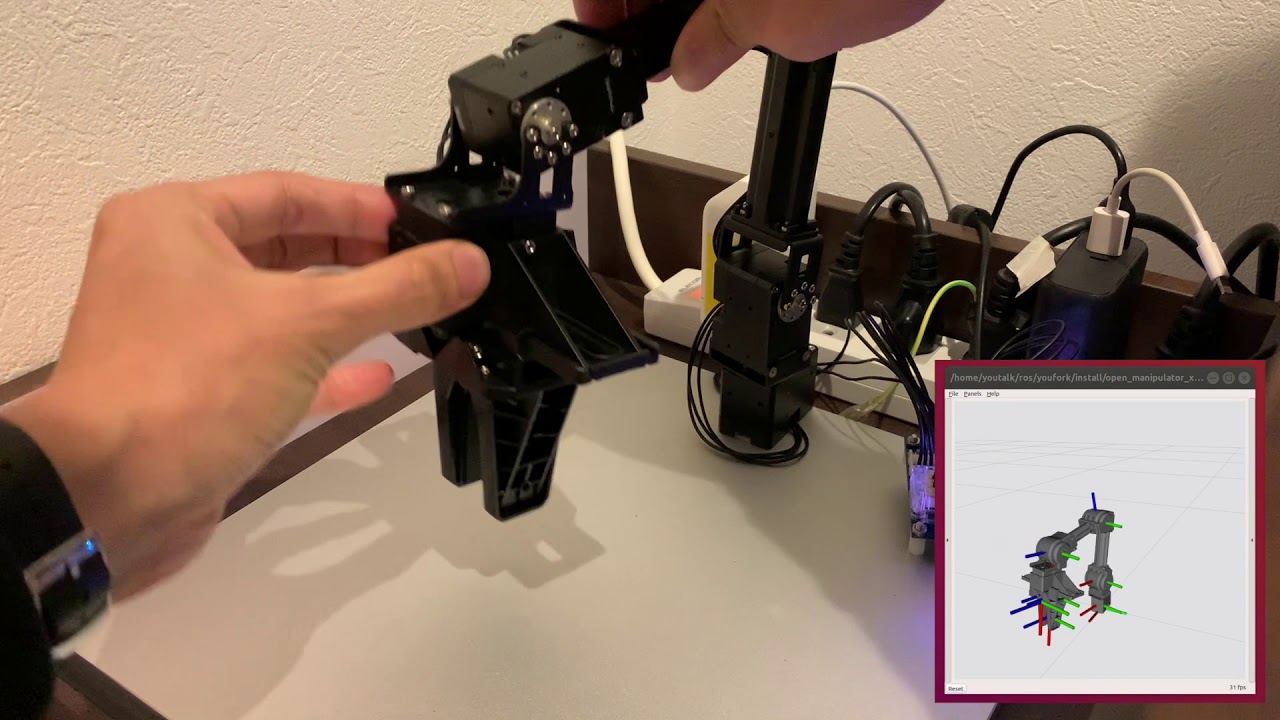IKNet is an inverse kinematics estimation with simple neural networks.
It can be run on Jetson family or PC with/without NVIDIA GPU. The training needs 900MB of GPU memory under default options.
This repository also contains the training and test dataset by manually moving the 4 DoF manipulator ROBOTIS Open Manipulator X.
Data collection
Set up
Install ROS 2 on Ubuntu 18.04 by following the ROBOTIS e-Manual.
https://emanual.robotis.com/docs/en/platform/openmanipulator_x/ros2_setup/#ros-setup
Then build some additional packages to modify a message open_manipulator_msgs/msg/KinematicsPose to add timestamp.
$ mkdir -p ~/ros2/src && cd ~/ros2/src
$ git clone https://github.com/youtalk/open_manipulator.git -b kinematics-pose-header
$ git clone https://github.com/youtalk/open_manipulator_msgs.git -b kinematics-pose-header
$ cd ~/ros2
$ colcon build
$ . install/setup.bash
Demo
First launch Open Manipulator X controller and turn the servo off to manually move it around.
$ ros2 launch open_manipulator_x_controller open_manipulator_x_controller.launch.py
$ ros2 service call /set_actuator_state open_manipulator_msgs/srv/SetActuatorState
Then collect the pair of the kinematics pose and the joint angles by recording /kinematics_pose and /joint_states topics under csv format.
$ ros2 topic echo --csv /kinematics_pose > kinematics_pose.csv & \
ros2 topic echo --csv /joint_states > joint_states.csv
Finally append the headers into them to load by Pandas DataFrame.
$ sed -i "1s/^/sec,nanosec,frame_id,position_x,position_y,position_z,orientation_x,orientation_y,orientation_z,orientation_w,max_accelerations_scaling_factor,max_velocity_scaling_factor,tolerance\n/" kinematics_pose.csv
$ sed -i "1s/^/sec,nanosec,frame_id,name0,name1,name2,name3,name4,position0,position1,position2,position3,position4,velocity0,velocity1,velocity2,velocity3,velocity4,effort0,effort1,effort2,effort3,effort4\n/" joint_states.csv
Training
Set up
Install PyTorch and the related packages.
$ conda install pytorch cudatoolkit=11.0 -c pytorch
$ pip3 install pytorch-pfn-extras matplotlib
Demo
Train IKNet with training dataset which is inside dataset/train directory or prepared by yourself. The dataset/train dataset contains a 5-minutes movement at 100 [Hz] sampling.
The training may be stopped before maximum epochs by the early stopping trigger.
$ python3 train_iknet.py --help
usage: train_iknet.py [-h] [--kinematics-pose-csv KINEMATICS_POSE_CSV]
[--joint-states-csv JOINT_STATES_CSV] [--train-val-ratio TRAIN_VAL_RATIO]
[--batch-size BATCH_SIZE] [--epochs EPOCHS] [--lr LR] [--save-model]
optional arguments:
-h, --help show this help message and exit
--kinematics-pose-csv KINEMATICS_POSE_CSV
--joint-states-csv JOINT_STATES_CSV
--train-val-ratio TRAIN_VAL_RATIO
--batch-size BATCH_SIZE
--epochs EPOCHS
--lr LR
--save-model
$ python3 train_iknet.py
epoch iteration train/loss lr val/loss
1 3 0.0188889 0.01 0.0130676
2 6 0.0165503 0.01 0.0132546
3 9 0.0167138 0.01 0.0134633
...
61 183 0.00267084 0.01 0.00428417
62 186 0.00266047 0.01 0.00461381
63 189 0.00260262 0.01 0.00461737
The loss indicates the L1 norm of the joint angles. So the final networks solved 0.00461737 [rad] accuracy in total.
Test
Demo
Evaluate accuracy of IKNet with test dataset which is inside dataset/test directory or prepared by yourself.
The dataset/test dataset contains a 1-minute movement at 100 [Hz] sampling.
$ python3 test_iknet.py --help
usage: test_iknet.py [-h] [--kinematics-pose-csv KINEMATICS_POSE_CSV]
[--joint-states-csv JOINT_STATES_CSV] [--batch-size BATCH_SIZE]
optional arguments:
-h, --help show this help message and exit
--kinematics-pose-csv KINEMATICS_POSE_CSV
--joint-states-csv JOINT_STATES_CSV
--batch-size BATCH_SIZE
$ python3 test_iknet.py
Total loss = 0.006885118103027344
Reference
- Theofanidis, Michail & Sayed, Saif & Cloud, Joe & Brady, James & Makedon, Fillia. (2018). Kinematic Estimation with Neural Networks for Robotic Manipulators: 27th International Conference on Artificial Neural Networks, Rhodes, Greece, October 4–7, 2018, Proceedings, Part III. 10.1007/978-3-030-01424-7_77.
- Duka, Adrian-Vasile. (2014). Neural Network based Inverse Kinematics Solution for Trajectory Tracking of a Robotic Arm. Procedia Technology. 12. 20–27. 10.1016/j.protcy.2013.12.451.



